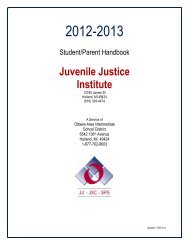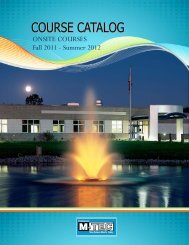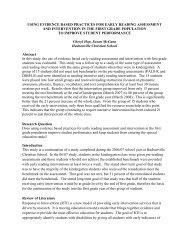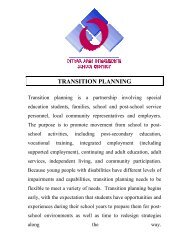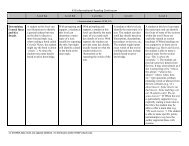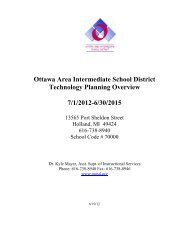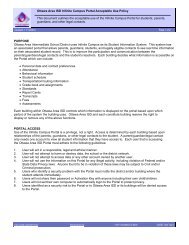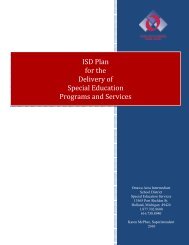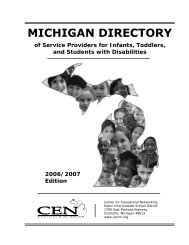Are DIBELS and Running Records effective tools for guiding ...
Are DIBELS and Running Records effective tools for guiding ...
Are DIBELS and Running Records effective tools for guiding ...
Create successful ePaper yourself
Turn your PDF publications into a flip-book with our unique Google optimized e-Paper software.
development plans in the area of language arts <strong>for</strong> all students. <strong>Running</strong> <strong>Records</strong> were collectedin September, January, <strong>and</strong> May, accompanied by <strong>DIBELS</strong> at the same intervals <strong>for</strong> benchmarkpurposes, <strong>and</strong> all students who were not benchmarked received progress monitoring to determinethe success of said interventions. This research study conducted at Douglas Elementary usedRigby <strong>Running</strong> <strong>Records</strong> <strong>and</strong> <strong>DIBELS</strong> to relate the use of data in selecting interventions, pacinginstruction, <strong>and</strong> <strong>guiding</strong> classroom teachers.Literature ReviewAssessment used to adapt teaching to meet student needs, known as <strong>for</strong>mative assessment, maybe considered the most important assessment practice educators use. Teachers use the results ofthis assessment approach proactively to differentiate instruction <strong>and</strong> better support studentlearning (Baker, S. Smith, <strong>and</strong> S. 2001).Research indicated that running records <strong>and</strong> Dynamic Indicators of Basic Early Literacy Skills(<strong>DIBELS</strong>), both <strong>for</strong>mative assessments, are <strong>effective</strong> <strong>tools</strong> <strong>for</strong> <strong>guiding</strong> classroom teachers towardchoosing interventions <strong>for</strong> students at risk of reading failure (Hebert, C. 2004).Connie R. Hebert (2004) wrote that teachers use running records to <strong>for</strong>m their reading groups, toguide them, <strong>and</strong> to make instructional decisions <strong>for</strong> individual students <strong>and</strong> the class as a whole.Hebert went on to say that running records are extremely valuable because they impactinstructional decisions such as grouping, text selection, verbal prompts, areas of concern <strong>and</strong>next steps in instruction.In a study done in 2004, John Ross found that teachers in <strong>effective</strong> schools are more likely to useclassroom assessment like running records to diagnose reading difficulties <strong>and</strong> to lead toinstruction. Assessing children’s reading progress is key to moving them along at the properdevelopmental rate. The combination of in<strong>for</strong>mation gained from the analysis of running recordswill help teachers select the appropriate books <strong>for</strong> the child’s reading level (Baker, Simmons,&Kame’enui 1997).<strong>DIBELS</strong> measures were designed to assess three areas of early literacy, Phonological Awareness,Alphabetic Principle <strong>and</strong> Fluency with connected text. These measures link together to <strong>for</strong>m anassessment system of early literacy development that allows educators to readily <strong>and</strong> reliablydetermine student progress <strong>and</strong> plan instruction accordingly (Adams, 1990; National ReadingPanel, 2000; National Research Council, 1998; Simmons & Kame’enui, 1998).Research DesignThe study was established to determine if there was an adequate correlation between <strong>DIBELS</strong><strong>and</strong> Rigby <strong>Running</strong> <strong>Records</strong> data, <strong>and</strong> that these data provided in<strong>for</strong>mation that would assistteachers in the general education classroom. Another goal of the study was to showcase the useof data in facilitating instruction <strong>and</strong> student achievement. During the study <strong>DIBELS</strong>in<strong>for</strong>mation was collected at benchmark periods in September, January, <strong>and</strong> April. Progressmonitoring was conducted every two weeks <strong>for</strong> students who were at-risk <strong>and</strong> not benchmarkedin the areas outlined in <strong>DIBELS</strong>. <strong>Running</strong> <strong>Records</strong> in<strong>for</strong>mation was collected in September,January, <strong>and</strong> April. <strong>Running</strong> <strong>Records</strong> were available <strong>for</strong> teachers to utilize as necessary to assistwith differentiating <strong>and</strong> <strong>guiding</strong> individual lessons <strong>for</strong> students.One teacher per grade level agreed to participate in the study. These teachers receivedin<strong>for</strong>mation every two weeks, received guidance from the reading interventionist, <strong>and</strong>participated in meetings at all benchmarked dates. Each teacher participating in the study wasgiven a survey midyear <strong>and</strong> one at the conclusion of the academic year. The in<strong>for</strong>mation asked



